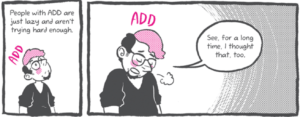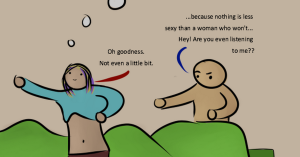
Stressed person with head in hands in front of their computer.
Safe space means different things to everyone, so it can be tough to create a space that’s accessible and inclusive to a wide range of different needs. It’s even harder to create a safe space on social media.
Technology keeps changing, so just when you think you’ve figured out Facebook’s algorithms and privacy settings, they’re suddenly different, and sometimes they change without you being notified.
I’ve encountered traumatizing content online, and I know my friends and communities have too.
But I’m also committed to making my online presence safe for people who want to interact with me, but maybe need a warning if an article I post has graphic images of violence or descriptions of sexual assault.
I share a fair amount of news across politics and entertainment, and I want my friends online to know what they’re virtually walking into ahead of time so they can make informed decisions about taking care of themselves.
Despite the challenges, here are some of the ways that we can all create a safer space on social media together:
1. Ask your community what they need, but also do your own research
Reach out to the folks in your community about what makes a safer space for them online.
Does anyone need me to write image descriptions for any images I post? What are some common types of content I should be tagging? Do I have any friends who’d like me to block them from specific types of content?
In the past, I’ve blocked friends from seeing statuses about Mother’s and Father’s Day, because they’ve asked their community to hide posts of that nature. They know it’ll hurt their grieving process or upset them because of an abusive relationship with a family member.
Some people want significant trauma-versaries blocked, especially if it happens to fall on a holiday (like Valentine’s Day or Halloween). There are common content warnings for things like violence, blood, and gore that I always use, and I’m happy to add more as needed.
It’s always helpful to be the one reaching out to your community rather than making it an individual person’s burden to have to ask you to put warnings on something.
You should also do your own research on common practices for safe spaces and accessible communities online, and ask yourself questions when you’re creating a post or sharing something: Is this article harmful to anyone, especially marginalized folks? Who might benefit from a content warning or a heads up that I’m posting this? Am I using ableist language or tone policing anyone?
2. Follow best practices for safe and accessible spaces
Be as thorough as you can in making sure the space is accessible and safe. When I’m thinking about content warnings, I try to be as specific as I can.
If the post I’m sharing is about campus sexual assault and rape, I’ll specify that; some people may be triggered by childhood sexual abuse but not by other forms of sexual violence, while some folks may really need a content warning for things relating to campus assault.
When I write image descriptions, I’m careful to follow best practices for inclusivity: I don’t make assumptions about race or gender identity in photos I’m describing, but I make sure to include skin tone and other identifying factors that marginalized people who use image descriptions may want to know about.
3. Utilize any tools that are available to you
There are some built-in social media features that can be useful, like the ability to unfollow people on Facebook if their posts tend to be harmful to you, or the use of tags on Tumblr.
It’s possible to block political posts from your Facebook feed if you find they’re draining your mental or physical energy.
Plugins and apps like Social Fixer, Facebook Purity, Remove All Politics From Facebook, TweetDeck (with its curated feeds), and Tumblr Savior can help you avoid things that might be traumatizing or toxic online.
You can also use features like Work Mode or StayFocusd to completely block social media for a set amount of time if you just need an incentive to step back and practice offline self-care.
4. Ask for help managing shared platforms
If, in addition to using your own social media channels, you’re also managing things for an organization or maintaining an online community such as a forum or a Facebook group, ask for help with moderation from your community.
As a community, you should have best practices and common scenarios laid out in a written policy. If you’re managing a Facebook group or a forum, for example, what will moderators do if someone breaks the policy?
How will moderators handle pushback and toxic members? If you’re moderating social media channels for an organization, what’s the strategy if someone who’s usually managing gets overwhelmed?
I’m a social media manager for a few organizations, and I’m also a part of several private Facebook groups and an active user of a few Tumblr hashtags. In the past, I was also a moderator for an online LGBTQIA+ forum.
In all of these instances, it has helped that I was a part of an actively engaged team, there was backup support for people doing the work, and we had policies in place that we were constantly adjusting to fit the needs of the community.
These types of social media jobs aren’t going anywhere and will continue to grow, so it makes sense that we come up with sustainable ways to manage them.
Your community can also step in with your own platforms if something specific comes up for your personal social media, like you want to check your On This Day but you know it’s a significant trauma-versary or if you’re fatigued by descriptions of hate crimes and violence in your newsfeed.
5. Be open and ready to adapt
Whether it’s your own triggers or someone else’s, it’s important to remain adaptive. Technology can and will change, and so can the needs of your community.
You might find that some days, images of your phobia don’t upset you that much but on other days, you really need to block everything related to it.
The best practice you can have is a plan to continuously monitor and see what can be changed. I used to write content warning descriptions at the top of a post with an article share in it, but recently, someone let me know that if the featured image that shows up for that article is violent or graphic, it will still be visible to people who might be harmed by it.
It’s better to nest the article within a regular post and offer a detailed content warning at the top of the post. Removing the image preview from the article is also an option on Facebook, as is removing the article preview on Twitter and just having a basic link.
***
As you’re creating an adaptable, inclusive safe space online, make sure to regularly check in — on your own needs, as well as the needs of your community.
Just because a form of oppression or a particular trauma doesn’t personally apply to you doesn’t mean it isn’t important to folks, and it’s best not to make assumptions about what people need.
Making sure that an online community is a safe and accessible space is difficult and is usually an ongoing process; you and your community might make mistakes, but you can also take accountability and learn from them.
[do_widget id=’text-101′]
Alaina Leary is an Everyday Feminism Reporting Fellow. She is a Bostonian currently studying for her MA in publishing at Emerson College. She’s a disabled, queer activist and is on the social media team at We Need Diverse Books. She can often be found re-reading her favorite books and covering everything in glitter. You can find her at her website or on Instagram and Twitter @alainaskeys. Read her articles here.
Search our 3000+ articles!
Read our articles about:
Our online racial justice training
Used by hundreds of universities, non-profits, and businesses.
Click to learn more




















